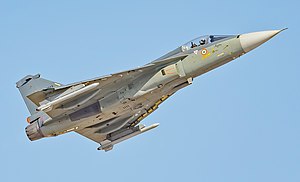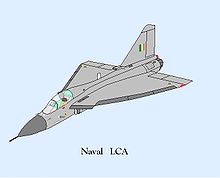HAL Tejas
| HAL Tejas | |
|---|---|
 Tejas at Aero India 2007 |
|
| Type: | Multipurpose fighter |
| Design country: | |
| Manufacturer: | |
| First flight: |
January 4, 2001 |
| Commissioning: |
20th December 2013 |
| Production time: |
In production |
| Number of pieces: |
24 |
The HAL Tejas ( Sanskrit : : "shining" ), developed under the project name Light Combat Aircraft ( LCA ), is a light, supersonic multi-role fighter aircraft produced by the Indian company Hindustan Aeronautics .
history
The development of the so-called "Light Combat Aircraft" (LCA) intended to replace the MiG-21 began in 1983. The first flight of the jet engine and delta wing aircraft took place on January 4, 2001. On May 4, 2003 Indian Prime Minister Atal Bihari Vajpayee announced the name Tejas . The Airbus Group is supporting the development of a carrier variant .
A first series order for 40 copies in an initial operational readiness was placed in 2006. In the end, only a part of this Tejas Mk.1 was built. The specimens delivered to the air force are on duty in the 45th Squadron (Flying Daggers) set up in Bangalore on July 1, 2016 .
The second series order for 40 fully operational units was placed in 2010 and the first flight of this Tejas Mk.1A took place in March 2020. A follow-up order for a further 83 units is planned. The first season has been the 18th Squadron (Flying Bullets) in Sulur since 2020 .
After the Mk.1 and Mk1.A series, the concept of the Mk.2 was developed, which was ultimately not implemented. At 17,500 kg, it was supposed to have a 4,000 kg higher maximum take-off mass and 1.35 m longer, which would have led to a shift in the center of gravity. She therefore needed canards (duck wings) and a modified wing. The range was increased by a larger fuselage tank and more hanging positions for additional tanks under the wings. Loads of up to 6.5 tons could have been carried at the wing stations, compared to 3.3 tons for the first series. In addition to the changes to the cell, the Mk.2 was to receive a number of changed or new systems, especially the sensors. A prototype, an LCA (N) Mk.1, completed the first successful carrier landing on the INS Vikramaditya in early 2020
Furnishing
The Tejas is equipped with a quadruple redundant fly-by-wire control based on the HOTAS principle (Hands On Throttle And Stick) and modern avionics. This includes multifunction displays in the cockpit suitable for night vision goggles (including three 5-inch screens), FADEC controls for the engine, inertial navigation system (INS) with laser gyro and pulse Doppler multi-mode radar . Selected from lithium-aluminum alloys , carbon fiber reinforced plastic (45% of the structural mass) and titanium alloys built airplane is equipped with a Martin-Baker - ejection seat equipped.
drive
Originally, the LCA was to be powered by the Indian Kaveri engine, which is still to be developed. After the Kaveri experienced increasing problems during the development phase, which could not be solved even with the help of the French engine manufacturer SNECMA , HAL resorted to the proven General Electric F404 -GE-F2J3 for the first series Tejas , the series designation of these machines is “Mark 1 ”(Mk.1), and wrote out the final engine.
The tender called for the delivery of finished engines as well as technology transfer and the license to build the engine in India. Candidates were the Eurojet EJ200 and the now selected General Electric F414- INS63, the machines equipped with them form the Mk.2 series. The contract was announced during a state visit by the US President to India. It includes a total of 99 (107 according to other sources) engines for $ 650 million, with an option for 49 more. The first eight engines will be delivered ready-made by GE, the remaining 91 will be delivered as kits to India and assembled there. The Eurojet consortium touted that the EJ200 was lighter than the competing engine, which meant that no changes to the design of the Tejas were required.
variants
Prototypes
Technology Demonstrator (TD)
- TD-1 (KH2001) - January 4, 2001
- TD-2 (KH2002) - June 6, 2002
Prototypes (PV)
- PV-1 (KH2003) - November 1, 2003
- PV-2 (KH2004) - December 2, 2005
- PV-3 (KH2005) - December 2, 2006 - production variant.
- PV-4 - initially planned as a carrier variant for the ( INS Vikrant ), now the name for the second production variant .
- PV-5 - Trainer version (two-seater) - November 2009
- PV-5 - Trainer version (two-seater) - November 2014
Carrier prototypes (NP):
- NP-1 - two seater - April 27, 2012
- NP-2 - single seater - February 2015
Pre-series
Eight pre-series machines are currently on order in English Limited Series Production (LSP) .
- LSP-1 (KH2011) - April 25, 2007
- LSP-2 - 2008.
- LSP-3 - Version with Multi-Mode Radar - 2010.
- LSP-4 to LSP-8 - flown until 2013 - LSP-8 corresponds to series production.
Series variants
- Tejas Mk.1 , single-seat fighter aircraft for the Indian Air Force , powered by an F404 engine, originally a series; 16 copies built
- Tejas Mk.1A ultimately realized variant of the Mk 1 with an AESA - Radar EL / M-2052 the company ELTA ; under construction, 40 ordered so far
- LCA Navy Mk.1 , technology carrier for a future twin-engine carrier fighter aircraft to replace the discarded Mk.2 series
- Tejas Mk.2 , planned and ultimately unrealized single-seat fighter aircraft for use on aircraft carriers of the Indian Navy , powered by an F414 engine.
- Tejas Trainer , planned two-seat trainer version for the Indian Air Force
Technical specifications
- General Information
- Crew: 1
- Length: 13.20 m
- Wingspan : 8.20 m
- Height: 4.40 m
- Wing area : 38.4 m²
- Empty weight : 5,500 kg
- Setup mass : 8,500 kg
- Max. Take-off weight :> 12,500 kg
- Drive:
- 1 × General Electric - Turbofan F414-INS63 with 65.64 kN (98.0 kN with afterburner)
- Internal fuel supply: 3,000 kg
- External fuel supply: 5 × 800 l tanks or 3 × 1,200 l tanks
- Price: Estimated $ 23 million each
- power
- Top speed: Mach 1.8 (1,990 km / h) at high altitude (Mach 1 at low altitude)
- Range : 2,000 km / 2.30 h (with internal fuel)
- Action radius : 510 km
- Service ceiling : 15,950 m
- Wing loading : 221.4 kg / m
- Thrust to weight ratio: 1.07
- Armament
- 1 × internal two- barreled 23 mm GSh-23 cannon with 220 rounds of ammunition
- 8 external load stations: three under each wing, a center for fuel and one for containers with additional equipment ( FLIR , IRST , laser - designator or investigation).
- Maximum external payload:> 4,000 kg.
- Air-to-air missiles , e.g. B. Astra, Wympel R-77 , Wympel R-73 .
- Air-to-ground armament, e.g. B. anti-ship missiles , laser-guided bombs , unguided bombs , cluster bombs and unguided air-to-surface missiles
- Other equipment
- Drop-off external tanks
- Container for electronic warfare , reconnaissance or target lighting
Web links
- Report on the Tejas test on the Frontier India website. (English)
- Website about the Tejas project at aerospaceweb.org. (English)
- "The Light Fighter Plane Puzzle" , "Frontline", on Hindu on Net , July 16, 2005. (English)
- Website about the light fighter / multi-role fighter Tejas at fighter-planes. (English)
- Unofficial website of the LCA-Tejas. (English)
Individual evidence
- ↑ Indiainfo.com: PM to select Sanskrit name for LCA on May 4 ( Memento of September 27, 2011 in the Internet Archive ) (accessed October 7, 2009)
- ↑ Indian Air Force to raise first Tejas LCA squadron, Janes, June 28, 2016 ( Memento from July 1, 2016 in the Internet Archive )
- ^ India launches $ 8 billion program for light combat aircraft, Defense News, December 20, 2017
- ↑ Indian Air Force commissions second Tejas LCA fighter squadron, Janes, May 27, 2020
- ↑ Indian Navy hits major milestone with its homegrown experimental jet. Defense News, Jan. 11, 2020
- ^ Initial Contract for 99 Engines to Pour $ 650 Million Into GE's Coffers. (No longer available online.) Archived from the original on October 9, 2010 ; Retrieved November 8, 2010 . Info: The archive link was inserted automatically and has not yet been checked. Please check the original and archive link according to the instructions and then remove this notice.
- ↑ India orders 99 GE F414 engines for Tejas fighter jet. Retrieved November 8, 2010 .
- ↑ USA and India sign trade agreements worth $ 10 billion. Retrieved November 8, 2010 .
- ^ Second naval Tejas prototype conducts maiden flight , Flightglobal, February 9, 2015
- ^ First carrier landing of the LCA, Flugrevue, January 11, 2018
- ↑ Tejas Mk. II maiden flight likely in 2019: defense minister, Flightglobal, August 5, 2015
- ↑ Tejas Mk2 gets canards, big payload boost, Flightglobal, February 20, 2019
- ^ IAF plans to order 201 Tejas LCA Mk 2 fighters, Janes, March 19, 2018
- ↑ Aeronautical Development Agency: Tejas specification (English) ( Memento from July 9, 2010 in the Internet Archive )
- ↑ India chooses F414 engine for Tejas. Retrieved November 8, 2010 .


